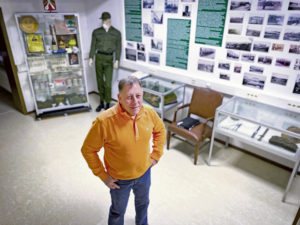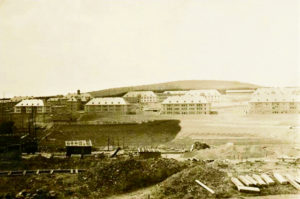
More than eighty years ago the farmland around the tiny village of Baumholder, Germany, was turned into a German Army training base. Today, Baumholder is one of the U.S. Army’s most important installations in Europe.
“The Rock,” as it’s affectionately called, has its origins in medieval times. For centuries farmers plowed the soil around the village. Then in 1935, the Wehrmacht (the German Army) needed space for basic training and the government appropriated 29,158 acres from landowners, displacing 842 families and 14 villages.
One man has made it his mission to make sure the history of Baumholder and the Baumholder Military Community (BMC) stays alive.
“The Baumholder Military Community has such a unique history that we have to preserve it and tell it,” said Bernd Mai, Baumholder Public Affairs specialist for the last 37 years. “I intended to tell the history to the young Soldiers who are here so they have a better understanding of why Baumholder is the way it is.”
The garrison dedicated a room inside the Baumholder Headquarters Building which has photos and artifacts showing the post’s history back to the late 1930s.
“The person who really got behind this was [former interim Deputy Garrison Manager] Nick Sifer,” Mai said. “He liked the idea of a historical room in the headquarters building and was helpful in getting the initiative approved and getting everything started.”
Mai said he has more than 20,000 photos digitized and he works on the room when his public affairs duties allow. He gets help from front office staff members when they have time and he also uses his network of friends and former Soldiers.
The French originally occupied the Baumholder installation after WWII, but the Americans took over it in a ceremony in 1951.
So far, the display cases and walls hold many WWII artifacts including personal items from Wehrmacht and American Soldiers, a couple of fine dining plates with the Nazi symbol on the underside found at a construction site earlier this year, a recently loaned full Vietnam-era American Army uniform and photos of a visit from then-President Bill Clinton and the first lady, Hillary Rodham Clinton in 1995. Mai said the First Lady’s return visit in 1996 was memorable for many reasons.

“The first lady was to meet with Baumholder dignitaries at an old restaurant on the edge of town that was easily made secure by the Secret Service. She walked in and the first thing she asked to see was the bathroom,” Mai remembered. “Nobody knew what to do because it hadn’t been planned. And, this was a bathroom that had not been updated since the early 1950s. It turns out she didn’t so much as want to see one, as use one. With all the little details planned by White House staff, nobody thought of a restroom break.”
Mai calls President Clinton’s visit one of the most significant events since the Americans took over the post.
The BMC was almost closed during troops cuts in 2012, but survived and in 2014 became part of the U.S. Army Garrison Rheinland-Pfalz.
“Baumholder is a very important part of the garrison and maintains a strategic role in the U.S. Army Europe and Africa training mission,” said Col. Vance Klosinski, USAG Rheinland-Pfalz commander. “In addition, this historical room also highlights the strong bonds of friendship forged between Americans and Germans in the area over the last seven decades.”
Some notable names to hold command positions in the BMC include: Gen. Dennis Reimer, former Chief of Staff of the Army who was 8th Infantry Division Division Artillery commander; Gen. George Casey, former Chief of Staff of the Army who was the 1st Armored Division assistant division commander and Gen. Raymond Odierno, former Chief of Staff of the Army who was also the 1st AD assistant division commander.
The Kimmit family also has a large role in the military history of Baumholder. Stan Kimmit, Secretary of the US Senate and Secretary for the Majority, Col. Stan Kimmit, 8th Infantry Division commander and his sons Robert Kimmit, former Deputy Secretary of the Treasury and U.S. Ambassador to Germany from 1991 to 1993, and Brig. Gen. Mark Kimmit, former 16th Assistant Secretary of State for Political-Military Affairs who was 1st Armored Division DIVARTY commander.
Willi Bus, is a former local national employee who worked at U.S. Army Depot Nahbollenbach for 14 years. He has restored two Vietnam-era Army vehicles and has loaned the Vietnam-era uniform from his personal collection to Mai because he believes the BMC has played a major role in America’s military history since WWII.
“The current generation of Soldiers should also be aware of their history and what their comrades have achieved for the current generation,” said Bus. “The items on loan to the historic room have a personal relevance for me as I served the U.S. Army for fourteen years.”
As the president of the German-American Friendship Committee of the city of Baumholder, Mai also provides lectures about the history of U.S. forces in Baumholder upon request.
Mai said he still has work to do on the room. He’s waiting on some supplies so he can complete the display but is happy to show off the artifacts. He said the room should be available to anyone with access to the installation and hopes Baumholder units include the room in any newcomer tours they give.
“Before a Soldier leaves Baumholder, they should have an idea of the history of the installation. That really helps a Soldier who is assigned here and believes he is at the end of the world.”


